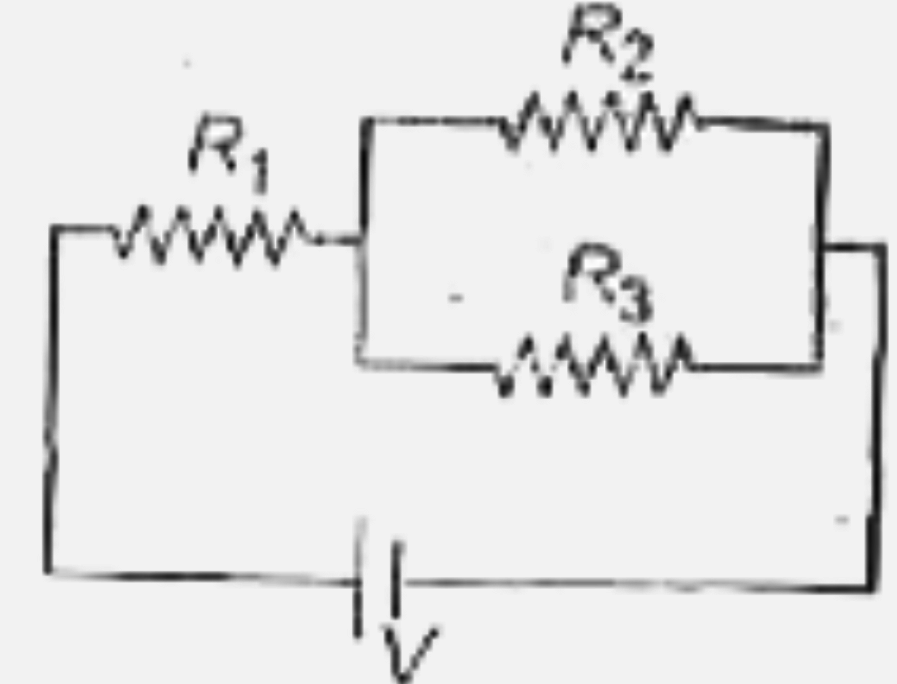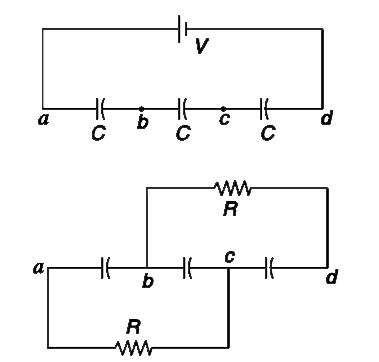Three identical capacitors are charged by connecting them in parallel across a battery of V volt. They are then allowed to discharge via resistor R1,R2andR3Here, Q charge versus t time graphs are shown. Then R1 is smallest or not.

The correct Answer is:R1 is largest
Step by step video & image solution for Three identical capacitors are charged by connecting them in parallel across a battery of V volt. They are then allowed to discharge via resistor R_1, R_2 and R_3Here, Q charge versus t time graphs are shown. Then R1 is smallest or not. by Physics experts to help you in doubts & scoring excellent marks in Class 12 exams.
Updated on:21/07/2023Topper's Solved these Questions
- Capacitance BOOK - MOTIONCHAPTER - Capacitance EXERCISE - EXERCISE -3 LEVEL II
17 Videos
- Capacitance BOOK - MOTIONCHAPTER - Capacitance EXERCISE - EXERCISE -4 LEVEL 1
15 Videos
- Capacitance BOOK - MOTIONCHAPTER - Capacitance EXERCISE - EXERCISE -2 LEVEL (II)
22 Videos
- CALORIMETRY BOOK - MOTIONCHAPTER - CALORIMETRY EXERCISE - EXERCISE - 3 Section - B
4 Videos
- CENTRE OF MASSBOOK - MOTIONCHAPTER - CENTRE OF MASSEXERCISE - Exercise - 4 Level-II
20 Videos
Similar Questions
Three identical resistors R1=R2=R3 are connected as shown to a battery of constant e.m.f . The power dissipated is

View SolutionThree identical capacitors, each of capacitance C are connected in series. The capacitors are charged by connecting a battery of emf V to the terminals (a and d) of the circuit. Now the battery is removed and two resistors of resistance R each are connected as shown. find the heat dissipated in one of the resistors

View Solution
Knowledge Check
Capacitors C1=1μF and C2=2μF are separately charged from the same battery. They are allowed to discharge separately through equal resistors
AThe currents in the two dicharging circuits at t=0 is zeroBThe currents in the two discharging circuits at t=0 are equal but not zeroCThe currents in the two discharging circuits at t=0 are unequalDC1 loses 50% of its initial charge sooner than C20 loses 50% of its initial charge.If an uncharged capacitor is charged by connecting it with an ideal battery and a resistance R as shown. Then heat generated in resistor R by the time capacitor stores energy 18CV2 is :
 A14CV2B38CV2C12CV2Dzero
A14CV2B38CV2C12CV2DzeroA capacitor is charged to a certain potential and then allowed to discharge through a resistance R. The ratio of charge on the capacitor to current in the circuit
Achanges with timeBdoes not change with time and it is equal to time constant of circuitCdoes not change with time, but not equal to time constant of circuitDmay or may not change depending upon the charge given to the capacitor
Area of each plate is A. The conducting plates are connected to a battery of emf V volts. Find charges q1 to qt.

View SolutionTwo resistors R1andR2 of 4Ωand6Ω are connected in parallel across a battery. The ratio of power dissipated in them, P1:P2 will be:
View SolutionAn uncharged capacitor C and a variable resistance R are connected to an ideal source and two resistors with the help of a switch at t=0 as shown in the figure. Initially capacitor is uncharged and switch S is closed at t=0sec. The graph between VA−VB for variable Resistor R for its three different values R1, R2, and R3 versus time is shown in the figure II. Choose the correct statement

View SolutionTwo ideal batteries of emf V1andV2 and three resistances R1,R2andR3 are connected as shown in the figure. The current in resistance R2 would be zero if

View Solutionthree identical capacitor, A,BandC are charged to the same potential and then made to discharge through three resistance RA>RB>RC. Their potential differnece (V) are plotted against time t, giving the curves 1,2,and3. Choose the incorrect option.

View Solution
